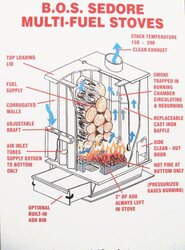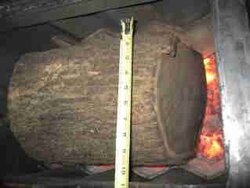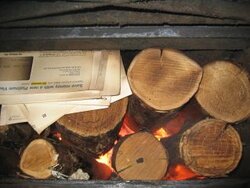Too wet , too green , 2 burn. Any advice, opinions, constructive critizem on this mess???
I have a couple cords of unseasoned and wet(was wetted Back in sept 07 in the bleach dip) wood,
as well as 4 cord seasoned (i presume it is seasoned) it was cut down in may 05 and left
stacked in the round at various lengths from 1 ft to 2 1/2 ft. for over 2 years, but the mushroom farm from page 2 of this post seems to be growing / flurishing well in my old 2005 wood.
They were just stacked up 5 ft high and left out uncovered for 2 years.
So, I know I have a lot of wood loss due to punky soft rot, those I take away to the dump.
But some of the rest of the mushroom farm, I hope to salvage some of the better of the wood.
So, I have been filling a wheelbarrow with chlorox bleach and water solution , and dipping my logs before splitting , because I dont want to get sick from the mold,mildew, fungus, rot, bacteria and virus that is all in there and I certainly dont want them germs in my house.
The bleach clean it up enough to handle it to split , dry and burn.
Do you guys know anything other than bleach to use 4 this??
NEED FASTER WAY OF DRYING WOOD--winters comming and I doubt if I have 1/4 cord thats
dry & seasoned.
Ok a little background---- back in 05 , I didnt have a chain saw, I dint have a log splitter and I didnt have a wood stove but I had a guy come buy and offer to cut down 7 trees for $500.oo
with no clean up whatsoever and I said yes.
It seems I was using the wrong tool 4 the job , a leaf vacuum with 52 trees and spending sept,oct ,nov, warm parts of dec ,march & april to some how find the grass under the leafs & filling 115 leaf bags in the process, each year.
So, 1 thing lead 2 another & I bought a chain saw , because the yard was full of big logs and then a 1960's smoking dragon basement burner with a 3 ft x 2 ft x 2ft firebox and finally,
in 06, a 2 hp electric 4 ton log splitter.
Which is why I have all that old wet and some rotting, wood .
New for 07 is a 30 ft. construction trailer, complete with bent axil and wobbly wheels, for $300.oo delevered , that makes an excellent wood shed.
_
Now I was wondering, if I restack my wood like a 4 conered fire stack "!-_!
so that air can get all around it & maybe put a fan on it too, then prehaps I can force season
some of the wood as I go along, enough to get by this winter.
The wood in the trailer is already 1/8thed or smaller and cut to 19 inch as my toy electric log spitter only has a 20 inch stroke and can barely split a 6 inch log. may stop dead in its tracks
on a 7 in ,8in,9,inor larger. Then you reduced to shaving of 2 inch slices from the outside of the log , until there nothing left.
In reality, it is an electric limb splitter, not log splitter. Add said: will split logs up to 14 inch diameter by 20 inch long, only $475.oo plus shipping and tax.
It do split 14 inch diameter log by shaving off 2 inch slices from the outside in, so you handle the log 7 times & 30 minutes to split it.
So, that why I have rotten logs and how can i season or dry them faster.
What you think about my box stacking and electric fan idea. Any merit or just wishfull thinking???
Any sugestions???? No room by the stove for more that 1 stack of boxed wood per side
and that only if i do a lot of moving of basement clutter.
I live in central conn. house is 30x30 basement,1st floor &2ed;floor for 2700sq ft with interior
redbrick chiminy.
Is red brick fire brick???? I broke one of the bricks in half that I got when the next door
neighbor demolished his chimney and it is red brick all the way through , not cement brick
like you see at home depot.
back in 2005, I didnt know about this web site * so I made some bad choices because of
lack of info. Ran oil burner here since before I was born but cant afford to buy oil any longer now at 5 times the price of 2002. Oil was .50 (50 cents a gallon) not $2.50 a gallon, like today.
House built 1910, no insulation, lattes & plaster interior walls.
I check back tonite, see whats 2 see.





